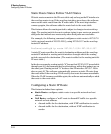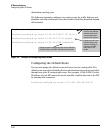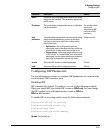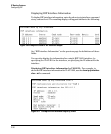
IP Routing Features
Configuring RIP
Note IP routing must be enabled prior to enabling RIP. The first command in the
preceding sequence enables IP routing.
Enabling IP RIP on a VLAN
To enable RIP on all IP addresses in a VLAN, use ip rip in the VLAN context.
when the command is entered without specifying any IP address, it is enabled
in all configured IP addresses of the VLAN.
To enable RIP on a specific IP address in a VLAN, use ip rip [< ip-addr >| all ] in
the VLAN context and enter a specific IP address. If you want RIP enabled on
all IP addresses, you can specify all in the command instead of a specific IP
address.
Changing the RIP Type on a VLAN Interface
When you enable RIP on a VLAN interface, RIPv2-only is enabled by default.
You can change the RIP type to one of the following on an individual VLAN
interface basis:
■ Version 1 only
■ Version 2 only (the default)
■ Version 1 - or - version 2
To change the RIP type supported on a VLAN interface, enter commands such
as the following:
ProCurve(config)# vlan 1
ProCurve(vlan-1)# ip rip v1-only
ProCurve(vlan-1)# exit
ProCurve(config)# write memory
Syntax: [no] ip rip < v1-only | v1-or-v2 | v2-only >
Changing the Cost of Routes Learned on a VLAN Interface
By default, the switch interface increases the cost of a RIP route that is learned
on the interface. The switch increases the cost by adding one to the route's
metric before storing the route.
You can change the amount that an individual VLAN interface adds to the
metric of RIP routes learned on the interface.
3-30


















